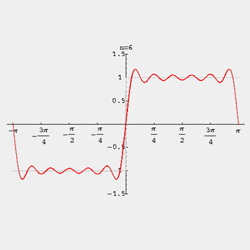
Reply by AndreasN
Made this illustration (Figure 1) in Izotope RX for another thread, but it seems perfectly fitting for this occasion too! =)
Reply by Kees de Visser
The practicle questions would be:
1) does it make sense to lower the signal level before SRC ?
2) would a fixed value of say -0.1 dB be adequate to eliminate all/most problems ?
3) would it be better to analyse the audio and calculate the smallest value needed to eliminate intersample overloads ?
My guess is 1:yes and 2:no. Any comments ?
I can imagine that option 3 is possible for file based SRC, but not for real-time hardware devices (unless a variable gain or a safety margin is acceptable).
In Reply to Bruno Putzeys
This means that even the “mostest perfectest” FIR LPF will cause intersample overs, and they won’t be related to the ripple in the frequency response.
Reply by bruno putzeys
@Andreas: Nice graph & a good illustration.
If you want to see intersample peaking at its worst, try the following series: -1,1,-1,1,…,1,-1,1,1,-1,1,…-1,1,-1
(ie. a full-scale fs/2 signal that’s suddenly phase-reversed). It’s a bit academic but it shows that there is theoretically no limit to the amount of intersample peaking that can occur.
In practice, the maximum is the sum of the absolute values of the FIR coefficients. If the filter is a half band, the maximum attainable intersample peak scales approximately with the logarithm of tap count.
@Kees: That shows that there is no amount of attenuation that guarantees no intersample overs. Attenuation is a band-aid.
The problem is not only linked to SRC. Anything that can overload an SRC will overload a DAC and vice versa. The simple fact is that not every thinkable data stream represents a legal signal. If the signal reconstructs >0dBfs, the signal is illegal. The signal described above is an extreme example of this.
If your audio does not produce overs after reconstruction, it will never cause overloads in SRC or AD/DA. It may still overload badly designed lossy codecs but I think it’s reasonable to require that codecs be at least able to handle legal signals correctly.
To verify if a signal is legal, use a reconstructing peak meter. Attenuate only if it indicates an over. Blanket attenuation is neither necessary nor sufficient to prevent intersample overs. Also, choose any limiter to have a reconstructing level detector (ones that have an option called “avoid intersample overs” or something similar).
Reply by johnR
Won’t mastering (or more specifically, limiting) at higher sample rates reduce the chances of intersample peaks occurring?
Reply by bruno putzeys
Practically speaking it will reduce the magnitude of the intersample overs but not the odds of them occurring. The only real solution is interpolating level detection in programme meters and limiters.
Reply by Bob Olhsson
In other words, higher sample rates just make it easier to measure the peak level.

